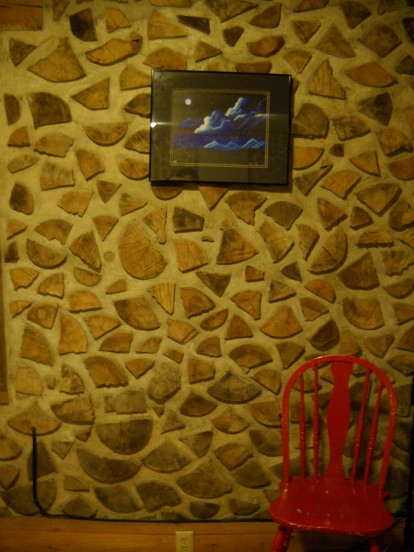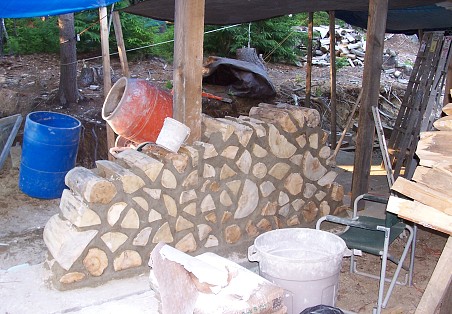Cordwood Construction in New England
 Cordwood construction for home building is unique, beautiful, inexpensive, and has excellent insulation properties. However, cordwood construction is not for those who want to build their new home rapidly. Todd Muller and his wife Patty Smythe of Wendell, MA have spent several years creating the home of their dreams, but no one is complaining. Muller and Smythe’s 1,300 square foot home is super energy efficient, eye-catching, and very personal. The sheer effort required to create a cordwood home is a big part of what truly makes it a home.
Cordwood construction for home building is unique, beautiful, inexpensive, and has excellent insulation properties. However, cordwood construction is not for those who want to build their new home rapidly. Todd Muller and his wife Patty Smythe of Wendell, MA have spent several years creating the home of their dreams, but no one is complaining. Muller and Smythe’s 1,300 square foot home is super energy efficient, eye-catching, and very personal. The sheer effort required to create a cordwood home is a big part of what truly makes it a home.
The Beginnings
Muller, who worked for many years as a carpenter and handyman, had never built a house before attempting to assemble a cordwood home. The story begins long before the 2005 construction start date on the family’s home. “It started for me in the 70s and the ‘back to the land’ movement,” remembers Muller. “There was the stereotype of hippies building a log cabin in the woods.” After watching a television program in that era about cordwood construction, Muller thought, “I can do that."
It did, however, take another 30 years for the seed that was planted to germinate.
Muller attended Earth Wood Building School in West Chazy, New York. He then left his job to work on the house-building project. While Smythe supported the couple during the building process, they feel ultimately they saved a great deal of money on a high-quality home by doing the work themselves. “We basically have a $250,000 home built for about $90,000,” claims Muller.

The Process of Cordwood Construction
Muller explains that first the trees/wood must be gathered, the bark peeled off, and the wood dried and cut to size: “It’s a similar process, except the peeling, to preparing wood for your wood pile (for burning).” Smythe adds that the ends of the wood should be sanded smooth.
Placing a square of cloth on the floor, Smythe demonstrates how the 24-inch-thick foundation was laid. “It has to be an especially strong foundation to be able to carry the weight,” she points out.
Once the floor plan was laid out, wood gathering began. Some wood came from the couple’s property and the rest they gleaned from various sources. In one instance, they were able to get three truckloads of wood from a company that was clearing an area which had flooded in another town.
Muller instructs that once you have your wood prepared, you then need a mortar composed of sand, Portland cement, lime and sawdust (soaked overnight). The cement is mixed in a wheelbarrow and the prepared wood piled for construction. Mortar is placed in a layer, then log pieces are placed, the middle is stuffed with insulating material, more mortar is put down and so on. The process of building one wall section approximately three by twelve feet takes about ten hours.
“It’s like a disease,” Muller laughs. “We became master mortar stuffers.”
“It’s like Zen building,” muses Smythe. It took a year and a half to build the first floor of the house.
Smythe cautions that it is very important to keep the project dry. After each workday, the project has to be “buttoned up and covered with tarps.” The areas around each log also need to be smoothed out by hand. “This was a primary tool,” Muller quips, holding up a mortar-covered butter knife.
Due to logistics and the time involved, the couple used standard construction technique for the second floor.

The Best Wood for Cordwood Construction
Muller warns that you do not want to use hardwoods in cordwood construction. “You need to select your wood based on its ability to transfer moisture. Eastern white cedar is the bomb when it comes to cordwood construction.”
Muller explains that woods with a lot of airspace allow for expansion and contraction more easily. Hardwoods would split and crack in relatively short order. The wood used in cordwood construction will dry over time, especially if you have a wood or pellet stove, which tends to create drier air in the house. After a year or two, you will most likely need to re-caulk around the wood to keep a tight fit. “We run a humidifier to help, but we would run one anyway,” remarks Smythe.
Other Benefits of Cordwood Construction
Again, the expenses are less. Smythe reveals that they needed only a small mortgage that they hope to pay off within the next three years.
The insulation can’t be beat. Walls are 16 inches thick. Muller mentions that one standard-sized woodstove and thermal mass heated floors they installed provide all the heat they need. The heated floors are run on propane currently, but Muller is looking to upgrade to a wood boiler for sustainability.
The wood you use can be very personal. Muller comes from three generations of builders and has used a wooden plane passed down through the family from Germany as one of the wall pieces. Smythe found fossilized heartwood for another personal touch.
Last, the couple learned from musicians they have had in their home for “house concerts,” that cordwood construction creates excellent acoustics.
Updated July 31, 2018.
Related Articles
Looking for a Pro? Call us (866) 441-6648

Carpentry Average Costs
Carpenters Experiences

Installing Nest Thermostat Almost As Hard As Learning To Use It

Great Prep, Great Results – My House Painting Was The Whole Deal



